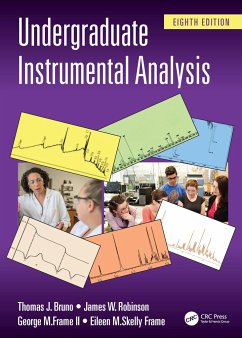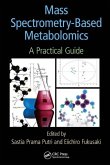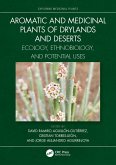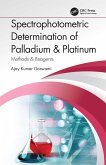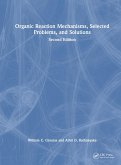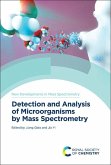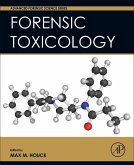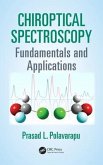Thomas J. Bruno, James W. Robinson (Louisiana State University, Baton Rouge, USA), George M. Frame II (New York State Department of Health, Albany, US
Undergraduate Instrumental Analysis
Thomas J. Bruno, James W. Robinson (Louisiana State University, Baton Rouge, USA), George M. Frame II (New York State Department of Health, Albany, US
Undergraduate Instrumental Analysis
- Gebundenes Buch
- Merkliste
- Auf die Merkliste
- Bewerten Bewerten
- Teilen
- Produkt teilen
- Produkterinnerung
- Produkterinnerung
This bestselling textbook provides students and users of analytical instrumentation with an understanding of these instruments, covering all major fields of instrumentation. This updated edition is ideal for teaching undergraduates and those with no analytical chemistry background how todayâ s instrumentation works and its uses and limitations.
Andere Kunden interessierten sich auch für
![Mass Spectrometry-Based Metabolomics Mass Spectrometry-Based Metabolomics]() Mass Spectrometry-Based Metabolomics52,99 €
Mass Spectrometry-Based Metabolomics52,99 €![Aromatic and Medicinal Plants of Drylands and Deserts Aromatic and Medicinal Plants of Drylands and Deserts]() Aromatic and Medicinal Plants of Drylands and Deserts221,99 €
Aromatic and Medicinal Plants of Drylands and Deserts221,99 €![Spectrophotometric Determination of Palladium & Platinum Spectrophotometric Determination of Palladium & Platinum]() Ajay Kumar GoswamiSpectrophotometric Determination of Palladium & Platinum131,99 €
Ajay Kumar GoswamiSpectrophotometric Determination of Palladium & Platinum131,99 €![Organic Reaction Mechanisms, Selected Problems, and Solutions Organic Reaction Mechanisms, Selected Problems, and Solutions]() William C. GroutasOrganic Reaction Mechanisms, Selected Problems, and Solutions154,99 €
William C. GroutasOrganic Reaction Mechanisms, Selected Problems, and Solutions154,99 €![Detection and Analysis of Microorganisms by Mass Spectrometry Detection and Analysis of Microorganisms by Mass Spectrometry]() Detection and Analysis of Microorganisms by Mass Spectrometry244,99 €
Detection and Analysis of Microorganisms by Mass Spectrometry244,99 €![Forensic Toxicology Forensic Toxicology]() Forensic Toxicology106,99 €
Forensic Toxicology106,99 €![Chiroptical Spectroscopy Chiroptical Spectroscopy]() Prasad L. Polavarapu (Vanderbilt University, Nashville, Tennessee,Chiroptical Spectroscopy277,99 €
Prasad L. Polavarapu (Vanderbilt University, Nashville, Tennessee,Chiroptical Spectroscopy277,99 €-
-
-
This bestselling textbook provides students and users of analytical instrumentation with an understanding of these instruments, covering all major fields of instrumentation. This updated edition is ideal for teaching undergraduates and those with no analytical chemistry background how todayâ s instrumentation works and its uses and limitations.
Hinweis: Dieser Artikel kann nur an eine deutsche Lieferadresse ausgeliefert werden.
Hinweis: Dieser Artikel kann nur an eine deutsche Lieferadresse ausgeliefert werden.
Produktdetails
- Produktdetails
- Verlag: Taylor & Francis Ltd
- 8 ed
- Seitenzahl: 996
- Erscheinungstermin: 31. Juli 2023
- Englisch
- Abmessung: 221mm x 288mm x 55mm
- Gewicht: 3016g
- ISBN-13: 9781032036915
- ISBN-10: 1032036915
- Artikelnr.: 67402123
- Herstellerkennzeichnung
- Libri GmbH
- Europaallee 1
- 36244 Bad Hersfeld
- gpsr@libri.de
- Verlag: Taylor & Francis Ltd
- 8 ed
- Seitenzahl: 996
- Erscheinungstermin: 31. Juli 2023
- Englisch
- Abmessung: 221mm x 288mm x 55mm
- Gewicht: 3016g
- ISBN-13: 9781032036915
- ISBN-10: 1032036915
- Artikelnr.: 67402123
- Herstellerkennzeichnung
- Libri GmbH
- Europaallee 1
- 36244 Bad Hersfeld
- gpsr@libri.de
Thomas J. Bruno was group leader in the Applied Chemicals and Materials Division at NIST, Boulder, Colorado before retiring in 2019. He received his B.S. in chemistry from Polytechnic Institute of Brooklyn, and his M.S. and Ph.D. in physical chemistry from Georgetown University. He has published over 270 research papers, 8 books, and has been awarded 10 patents. He serves as associate editor of the CRC Handbook of Chemistry and Physics, and associate editor for Fuel Processing Technology. The late James W. Robinson earned his BS (Hons), PhD, and DSc from the University of Birmingham, England. A fellow of the Royal Society of Chemistry, he was author of 250 research papers, book chapters, and several books. He was editor in chief of Spectroscopy Letters and the Journal of Environmental Science and Health (both Marcel Dekker, Inc.); executive editor of Handbook of Spectroscopy Vol. 1 (1974), Vol. 2 (1974), Vol. 3 (1981); and Practical Handbook of Spectroscopy (1991) (all CRC Press). Professor Emeritus James W. Robinson passed away in November, 2018, at 95 years of age. The late Eileen M. Skelly Frame was the first woman commissioned from the Drexel University Army ROTC program, graduating summa cum laude in chemistry. She served as Medical Service Corps officer in the U.S. Army from 1975 to 1986, rising to the rank of Captain. She received her doctorate in 1982, and became the first female chemistry professor at the U.S. Military Academy at West Point. She was adjunct professor, Department of Chemistry and Chemical Biology, Rensselaer Polytechnic Institute (RPI), Troy, NY, and head of Full Spectrum Analytical Consultants. Dr. Skelly Frame passed away in January of 2020. George M. Frame II earned his AB in chemistry from Harvard College, Cambridge, Massachusetts, and his PhD in analytical chemistry from Rutgers University, New Brunswick, New Jersey. He is a retired scientific director, Chemical Biomonitoring Section of the Wadsworth Laboratory, New York State Department of Health, Albany. He has a wide range of experience in analytical chemistry and has worked at the GE Corporate R&D Center (now GE Global Research), Pfizer Central Research, the US Coast Guard R&D Center, the Maine Medical Center, and in the US Air Force Biomedical Sciences Corps.
1.Concepts of Instrumental Analytical Chemistry. 2.Safety in the
Instrumentation Laboratory.3. Introduction to Spectroscopy. 4. Visible and
Ultraviolet Molecular Spectroscopy. 5. Infrared, Near-Infrared, Raman, and
Photoacoustic Spectroscopy. 6. Magnetic Resonance Spectroscopy. 7. Atomic
Absorption Spectrometry. 8. Atomic Emission Spectroscopy. 9. X-Ray
Spectroscopy. 10. Mass Spectrometry I: Principles and Instrumentation. 11.
Mass Spectrometry II: Spectral Interpretation and Applications. 12.
Principles of Chromatography. 13. Gas Chromatography. 14. Chromatography
with Liquid (and Fluid) Mobile Phases. 15. Electroanalytical Chemistry. 16.
Surface Analysis.17. Thermal Analysis.
Instrumentation Laboratory.3. Introduction to Spectroscopy. 4. Visible and
Ultraviolet Molecular Spectroscopy. 5. Infrared, Near-Infrared, Raman, and
Photoacoustic Spectroscopy. 6. Magnetic Resonance Spectroscopy. 7. Atomic
Absorption Spectrometry. 8. Atomic Emission Spectroscopy. 9. X-Ray
Spectroscopy. 10. Mass Spectrometry I: Principles and Instrumentation. 11.
Mass Spectrometry II: Spectral Interpretation and Applications. 12.
Principles of Chromatography. 13. Gas Chromatography. 14. Chromatography
with Liquid (and Fluid) Mobile Phases. 15. Electroanalytical Chemistry. 16.
Surface Analysis.17. Thermal Analysis.
1.Concepts of Instrumental Analytical Chemistry. 2.Safety in the
Instrumentation Laboratory.3. Introduction to Spectroscopy. 4. Visible and
Ultraviolet Molecular Spectroscopy. 5. Infrared, Near-Infrared, Raman, and
Photoacoustic Spectroscopy. 6. Magnetic Resonance Spectroscopy. 7. Atomic
Absorption Spectrometry. 8. Atomic Emission Spectroscopy. 9. X-Ray
Spectroscopy. 10. Mass Spectrometry I: Principles and Instrumentation. 11.
Mass Spectrometry II: Spectral Interpretation and Applications. 12.
Principles of Chromatography. 13. Gas Chromatography. 14. Chromatography
with Liquid (and Fluid) Mobile Phases. 15. Electroanalytical Chemistry. 16.
Surface Analysis.17. Thermal Analysis.
Instrumentation Laboratory.3. Introduction to Spectroscopy. 4. Visible and
Ultraviolet Molecular Spectroscopy. 5. Infrared, Near-Infrared, Raman, and
Photoacoustic Spectroscopy. 6. Magnetic Resonance Spectroscopy. 7. Atomic
Absorption Spectrometry. 8. Atomic Emission Spectroscopy. 9. X-Ray
Spectroscopy. 10. Mass Spectrometry I: Principles and Instrumentation. 11.
Mass Spectrometry II: Spectral Interpretation and Applications. 12.
Principles of Chromatography. 13. Gas Chromatography. 14. Chromatography
with Liquid (and Fluid) Mobile Phases. 15. Electroanalytical Chemistry. 16.
Surface Analysis.17. Thermal Analysis.

